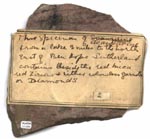The Scottish 'Diamond' Rediscovered
Published: 17 February 2003
A scientist at the University of Glasgow's Hunterian Museum solves a century old mystery...
Dr John Faithfull, the mineralogist at the University of Glasgow's Hunterian Museum has rediscovered the Scottish 'diamond' specimen, missing for nearly a century.
For over a hundred years, it has been believed that a diamond was found near 'a lake 3 miles north east of Ben Hope' in Sutherland. This belief was based on a specimen found by the great Scottish mineralogist and chemist, Matthew Forster Heddle, and described in a posthumous supplement to his book 'The Mineralogy of Scotland'in 1901.
The specimen was described by Heddle as containing either '...colourless garnets or Diamonds..', but his son-in-law Alexander Thoms, stated in the posthumous published account that when Heddle gave the specimen to him, he indicated that he thought diamond the most likely identification. Given Heddle's qualities as a scientist, this was definitely an intriguing observation.
The description given is quite unlike most diamond-bearing rocks known, but occasional diamonds do turn up in unusual geological situations. Following its mention in the book, the specimen disappeared and no geologist seems to have seen it during almost the whole of the 20th century.
Many have sought the diamonds of Ben Hope but, as the specimen had never been seen since its mention in the book, people didn't know exactly what they were looking for. Also, 'three miles north-east of Ben Hope' turns out to be a boggy plateau covered in myriads of small lochans with no single clearly identifiable 'lake'.
Nobody has found any diamonds near Ben Hope, but the original description has retained its tantalising hold over those interested in Scottish gemstones. The key to all this would have been the original specimen. But where was it?
Alexander Thoms collection was little known, but survived in Dundee. In the early 1990's, it was transferred to the University of Glasgow, and eventually to the Hunterian Museum. The museum mineralogist, Dr. John Faithfull, had been interested in Scottish minerals and gemstones since boyhood and knew of the account of the Ben Hope diamond and of the names of Alexander Thoms and Heddle.
Thoms' collection was in excellent order and was accompanied by a numbered catalogue. Entry number 2 in the catalogue was for the, "?Diamond", specimen from Ben Hope. Unfortunately, although almost all the other specimens in the collection were easily located, number two wasn't there! Despite extensive searching, the specimen didn't turn up. So near, and yet so far ヨ it seemed as though the mystery of the Ben Hope diamond would remain forever unsolved.
Then, a few years later, another geologist at the University of Glasgow was sorting through some old rocks that had been used for student teaching in the Geology Department. Most of the material was rubbish, destined for the skip, but he did notice one specimen with an adhering old label containing the word 'diamond' and put the specimen aside.
Shortly afterwards, Dr. Faithfull happened to be visiting a colleague in the Geology Department and noticed a specimen with an old label on a shelf. What caught his eye was the handwriting ヨ it was that of Matthew Forster Heddle! Furthermore, it had exactly the text recorded in 'The Mineralogy of Scotland' almost a century before and it had a small number '2' stuck on it ヨ this was Heddle's diamond!
Dr Faithfull then began the process of examining the specimen using modern scientific techniques. The results were clear - there were no diamonds in the sample. As Heddle had said 100 years before, '...either colourless garnets or diamonds' ヨ these indeed were colourless garnets!
As Dr Faithfull comments, 'People don't like uncertainty although it can be a frequent occurrence in science. Offered a specimen that might have been diamond, people wanted it to be diamond - and so forgot about the other possibilities!'
'However', he added, ' there is a twist in the tail of the story. As well as the garnets, the specimen contained some microscopic grains of unusual minerals, one of which had never before been recorded in Scotland. Its occurrence may be of interest in understanding the geological history of the rocks of Sutherland. Fieldwork north-east of Ben Hope has revealed more of this material, although so far it has only been found as loose glacially-transported blocks.
Work on these specimens continues and Heddle's 'diamond' may yet have some lasting scientific, if not commercial, significance!'
Media Relations Office (media@gla.ac.uk)
Please contact the University Press Office on 0141 330 3535 / 3683
First published: 17 February 2003
<< February


